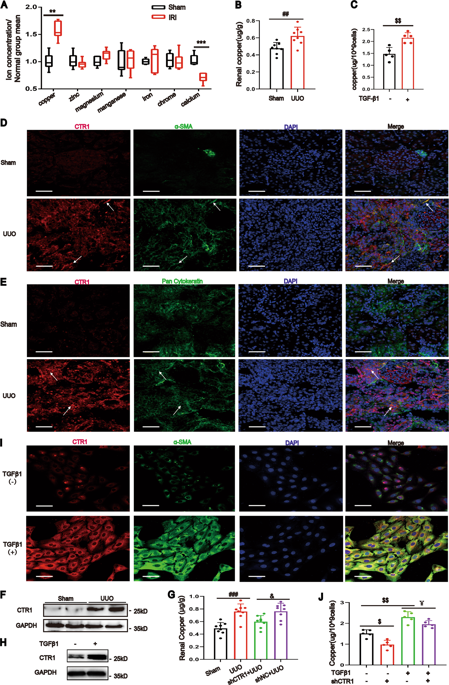Cell Death & Disease ( IF 8.1 ) Pub Date : 2020-03-31 , DOI: 10.1038/s41419-020-2404-5 Yang-yang Niu , Ying-ying Zhang , Zhi Zhu , Xiao-qin Zhang , Xi Liu , Sai-ya Zhu , Ye Song , Xian Jin , Bengt Lindholm , Chen Yu

|
Copper ions play various roles in mammalian cells, presumably due to their involvement in different enzymatic reactions. Some studies indicated that serum copper correlates with fibrosis in organs, such as liver and lung. However, the mechanism is unknown. Here, we explored the role of copper in kidney fibrosis development and possible underlying mechanisms. We found that copper transporter 1 (CTR1) expression was increased in the kidney tissues in two fibrosis models and in patients with kidney fibrosis. Similar results were also found in renal tubular epithelial cells and fibroblast cells treated with transforming growth factor beta (TGF-β). Mechanistically, the upregulation of CTR1 required Smads-dependent TGF-β signaling pathway and Smad3 directly binded to the promoter of CTR1 in renal fibroblast cells using chromatin immunoprecipitation. Elevated CTR1 induced increase of copper intracellular influx. The elevated intracellular copper ions activated lysyl oxidase (LOX) to enhance the crosslinking of collagen and elastin, which then promoted kidney fibrosis. Reducing intracellular copper accumulation by knocking down CTR1 ameliorated kidney fibrosis in unilateral ureteral obstruction induced renal fibrosis model and renal fibroblast cells stimulated by TGF-β. Treatment with copper chelator tetrathiomolybdate (TM) also alleviated renal fibrosis in vivo and in vitro. In conclusion, intracellular copper accumulation plays a unique role to kidney fibrosis by activating LOX mediated collagen and elastin crosslinking. Inhibition of intracellular copper overload may be a potential portal to alleviate kidney fibrosis.
中文翻译:

升高的细胞内铜通过赖氨酰氧化酶介导的基质交联对肾脏纤维化起独特作用
铜离子在哺乳动物细胞中起着各种作用,大概是由于它们参与了不同的酶促反应。一些研究表明,血清铜与器官(如肝和肺)的纤维化有关。但是,该机制是未知的。在这里,我们探讨了铜在肾脏纤维化发展中的作用以及可能的潜在机制。我们发现铜转运蛋白1(CTR1)的表达在两种纤维化模型和肾纤维化患者的肾脏组织中增加。在用转化生长因子β(TGF-β)处理的肾小管上皮细胞和成纤维细胞中也发现了相似的结果。从机制上讲,CTR1的上调需要Smads依赖性TGF-β信号通路,而Smad3使用染色质免疫沉淀法直接与肾成纤维细胞中CTR1的启动子结合。CTR1升高引起铜细胞内流入增加。升高的细胞内铜离子激活赖氨酰氧化酶(LOX),以增强胶原蛋白和弹性蛋白的交联,进而促进肾脏纤维化。通过降低CTR1改善单侧输尿管梗阻诱导的肾纤维化模型和TGF-β刺激的肾成纤维细胞中的肾纤维化,减少细胞内铜的积累。用铜螯合剂四硫代钼酸盐(TM)治疗还可以减轻体内和体外的肾纤维化。总之,细胞内铜的积累通过激活LOX介导的胶原蛋白和弹性蛋白交联,对肾脏纤维化起着独特的作用。抑制细胞内铜过载可能是减轻肾脏纤维化的潜在途径。升高的细胞内铜离子激活赖氨酰氧化酶(LOX),以增强胶原蛋白和弹性蛋白的交联,进而促进肾脏纤维化。通过降低CTR1改善单侧输尿管梗阻诱导的肾纤维化模型和TGF-β刺激的肾成纤维细胞中的肾纤维化,减少细胞内铜的积累。用铜螯合剂四硫代钼酸盐(TM)治疗还可以减轻体内和体外的肾纤维化。总之,细胞内铜的积累通过激活LOX介导的胶原蛋白和弹性蛋白交联,对肾脏纤维化起着独特的作用。抑制细胞内铜过载可能是减轻肾脏纤维化的潜在途径。升高的细胞内铜离子激活赖氨酰氧化酶(LOX),以增强胶原蛋白和弹性蛋白的交联,进而促进肾脏纤维化。通过降低CTR1改善单侧输尿管梗阻诱导的肾纤维化模型和TGF-β刺激的肾成纤维细胞中的肾纤维化,减少细胞内铜的积累。用铜螯合剂四硫代钼酸盐(TM)治疗还可以减轻体内和体外的肾纤维化。总之,细胞内铜的积累通过激活LOX介导的胶原蛋白和弹性蛋白交联,对肾脏纤维化起着独特的作用。抑制细胞内铜过载可能是减轻肾脏纤维化的潜在途径。然后促进肾纤维化。通过降低CTR1改善单侧输尿管梗阻诱导的肾纤维化模型和TGF-β刺激的肾成纤维细胞中的肾纤维化,减少细胞内铜的积累。用铜螯合剂四硫代钼酸盐(TM)治疗还可以减轻体内和体外的肾纤维化。总之,细胞内铜的积累通过激活LOX介导的胶原蛋白和弹性蛋白交联,对肾脏纤维化起着独特的作用。抑制细胞内铜过载可能是减轻肾脏纤维化的潜在途径。然后促进肾纤维化。通过降低CTR1改善单侧输尿管梗阻诱导的肾纤维化模型和TGF-β刺激的肾成纤维细胞中的肾纤维化,减少细胞内铜的积累。用铜螯合剂四硫代钼酸盐(TM)治疗还可以减轻体内和体外的肾纤维化。总之,细胞内铜的积累通过激活LOX介导的胶原蛋白和弹性蛋白交联,对肾脏纤维化起着独特的作用。抑制细胞内铜过载可能是减轻肾脏纤维化的潜在途径。用铜螯合剂四硫代钼酸盐(TM)治疗还可以减轻体内和体外的肾纤维化。总之,细胞内铜的积累通过激活LOX介导的胶原蛋白和弹性蛋白交联,对肾脏纤维化起着独特的作用。抑制细胞内铜过载可能是减轻肾脏纤维化的潜在途径。用铜螯合剂四硫代钼酸盐(TM)治疗还可以减轻体内和体外的肾纤维化。总之,细胞内铜的积累通过激活LOX介导的胶原蛋白和弹性蛋白交联,对肾脏纤维化起着独特的作用。抑制细胞内铜过载可能是减轻肾脏纤维化的潜在途径。











































 京公网安备 11010802027423号
京公网安备 11010802027423号